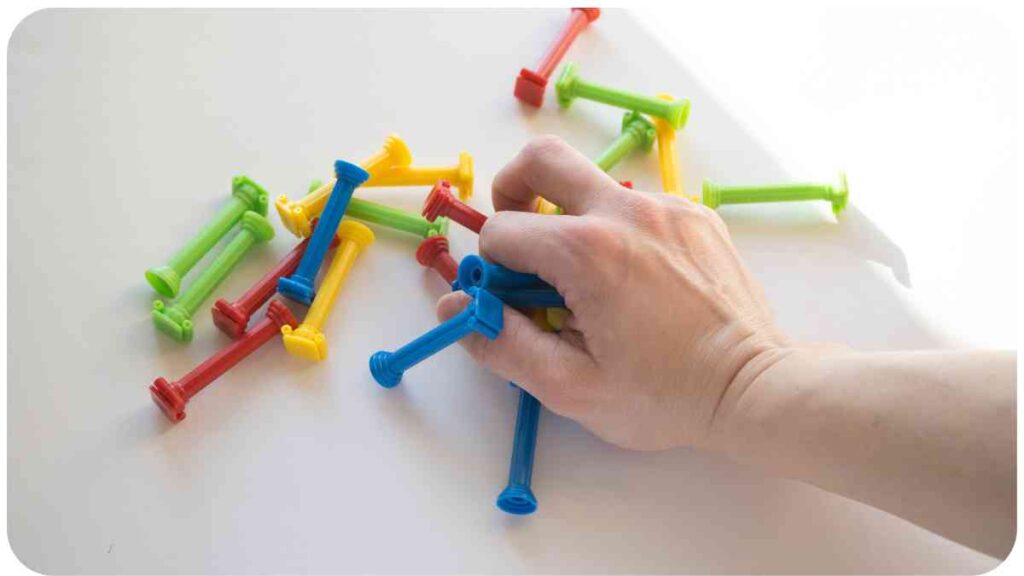Welcome to this step-by-step guide on creating your very own Sensory Wall! In this article, we will delve into the fascinating world of sensory walls, their benefits, and how you can construct your own for therapeutic or recreational purposes.
Whether you are a parent, teacher, therapist, or simply someone interested in sensory experiences, this guide will provide you with all the necessary information to embark on this exciting project.
| Takeaways |
| Creating a sensory wall can be a rewarding DIY project, offering numerous benefits and possibilities. |
| Consider the unique sensory needs and preferences of the individuals who will be using the sensory wall. |
| Incorporate a variety of sensory experiences, such as visual, auditory, tactile, and olfactory stimuli. |
| Regularly update and maintain the sensory features and materials to keep the wall engaging and safe. |
| Sensory walls can be utilized in various settings, including schools, hospitals, and homes, to promote well-being and learning. |
2. What is a Sensory Wall?
A sensory wall is a tactile and interactive installation designed to stimulate the senses. It typically consists of a variety of materials, textures, colors, lights, and sounds arranged on a wall surface. Sensory walls are popular in sensory rooms, classrooms, therapy centers, and even homes, as they offer a wide range of benefits for individuals of all ages, including children with sensory processing disorders or developmental challenges.
Refreshing old potting soil is a breeze with these tips and tricks. Keep your soil vibrant and your plants healthy by following our step-by-step guide on refreshing old potting soil. Your sensory wall will thrive with rejuvenated soil.
3. Why Create a Sensory Wall?

Sensory walls provide a multitude of benefits, including cognitive, motor, and emotional development. They can help improve sensory integration, fine motor skills, hand-eye coordination, concentration, and creativity. In addition, sensory walls offer a safe and controlled environment for individuals to explore and engage with different sensory experiences.
Creating a sensory wall is not only an enriching activity, but it also provides a meaningful and personalized space for individuals to self-regulate and find comfort. By incorporating sensory elements that cater to specific preferences and needs, a sensory wall becomes a therapeutic tool that promotes relaxation, engagement, and overall well-being.
4. Materials Needed
Before you embark on your sensory wall project, gather the following materials:
Table 1: Materials Checklist
| Materials | Quantity |
| Wall panels or boards | 1 |
| Mounting brackets | As needed |
| Adhesive | As needed |
| Sensory features | Varies |
| Sensory materials | Varies |
| Tools (screwdriver, drill, etc.) | As needed |
| Safety equipment | As needed |
Please note that the quantity of materials may vary depending on the size and complexity of your sensory wall design.
5. Step 1: Planning and Design
Proper planning and design are crucial for creating a functional and engaging sensory wall. Consider the available space, the individuals who will be using the wall, and their specific sensory needs. Take into account sensory preferences, such as visual, auditory, tactile, and olfactory stimuli.
Looking to create the perfect potting mix for your DIY sensory wall? Learn how to make the most of your indoor gardening with insights from our article on making good potting soil for vegetables. Your plants will thank you!
Table 2: Sensory Wall Design Ideas
| Design Element | Description |
| Colorful fabric | Soft and visually stimulating |
| Bumpy textures | Tactile and sensory-rich |
| LED light panels | Visual appeal and mood enhancement |
| Musical chimes | Auditory stimulation and relaxation |
| Scented objects | Olfactory experiences for mood enhancement |
6. Step 2: Preparing the Wall
Before installing the sensory features, it’s essential to prepare the wall to ensure a stable and secure foundation for your sensory wall. Follow these steps to get started:
- Clean the wall surface thoroughly, removing any dirt, dust, or debris that may interfere with the adhesive or mounting brackets. Use a mild cleanser and a clean cloth or sponge.
- Repair any cracks, bumps, or imperfections on the wall. Fill in holes with spackling compound and sand the surface smooth. This step ensures a flat and even wall surface for installation.
- Measure the dimensions of the wall and mark the desired location of the sensory features. Use a level to ensure accuracy and symmetry.
- Install the mounting brackets according to the manufacturer’s instructions. These brackets will provide support for the sensory features.
- Apply adhesive to the back of the wall panels or boards, following the adhesive manufacturer’s guidelines. Carefully and securely attach the panels to the wall, aligning them with the mounting brackets.
8. Step 3: Installing the Sensory Features

Now that your wall is prepared, it’s time to install the sensory features. These features can be selected based on the specific sensory needs and preferences of the individuals using the sensory wall. Here are some commonly used sensory features along with a comparison table to help you make informed decisions.
Achieve the best results for your sensory wall by considering the essential factors in potting soil. Explore the key aspects of potting soil in our guide on what to look for in potting soil. Your plants will flourish with the right soil choice.
Table 4: Sensory Features Comparison
| Sensory Feature | Description | Benefits |
| Bubble Wall | A wall-mounted panel with continuously rising bubbles | Visual stimulation, calming effect |
| Fiber Optic Lights | Strands of color-changing lights that emit gentle glows | Visual stimulation, calming effect |
| Interactive Panels | Panels that respond to touch, sound, or light | Tactile, auditory, or visual stimulation, cause-and-effect learning |
| Mirror Panels | Reflective surfaces that provide visual feedback | Visual stimulation, self-awareness |
| Tactile Wall Elements | Textured surfaces or materials on the wall for sensory exploration | Tactile stimulation, fine motor skills development |
Choose sensory features that align with your design goals and the sensory needs of the users. It’s important to ensure that the chosen features are of high quality and meet safety standards.
8. Step 4: Enhancing Sensory Stimulation
Now that the sensory features are installed, it’s time to enhance the overall sensory stimulation of your wall. This step involves selecting and incorporating various sensory materials that can be interacted with and explored. Consider the following options and refer to the comparison table for a detailed overview.
Table 6: Sensory Materials Comparison
| Sensory Material | Description | Benefits |
| Soft Textiles | Fabrics with different textures, such as fur, velvet, or satin | Tactile stimulation, comfort, sensory exploration |
| Visual Artwork | Vibrant and visually stimulating images or patterns | Visual stimulation, artistic expression |
| Scented Elements | Fragrant objects or materials, such as scented pouches or oils | Olfactory stimulation, aromatherapy, mood enhancement |
| Manipulative Objects | Objects that can be manipulated, such as fidget toys or puzzles | Fine motor skills development, hand-eye coordination, stress relief |
By incorporating a variety of sensory materials, you provide opportunities for individuals to engage with different senses and further enhance their sensory experiences.
9. Step 5: Ensuring Safety and Maintenance
Safety is of utmost importance when creating a sensory wall. Take the following precautions and refer to the safety guidelines table for further reference:
Table 9: Maintenance Schedule
| Maintenance Task | Frequency |
| Wipe down sensory wall surfaces | Weekly |
| Inspect and clean sensory features | Monthly |
| Check and tighten mounting brackets | Quarterly |
Regular maintenance and inspection will help keep the sensory wall safe, functional, and enjoyable for everyone.
Maintaining your sensory wall’s soil is vital. Discover the ideal frequency for replacing potting soil with insights from our article on how often to replace potting soil. Keep your wall vibrant and thriving with timely soil changes.
10. Tips for a Successful Sensory Wall
- Consider the specific sensory needs and preferences of the individuals who will be using the sensory wall. This will ensure that the features and materials are tailored to their unique requirements.
- Incorporate a variety of sensory experiences, such as visual, auditory, tactile, and olfactory stimuli, to provide a well-rounded sensory environment.
- Take inspiration from existing sensory wall designs and adapt them to suit your space and requirements. Don’t be afraid to get creative and think outside the box.
- Involve the individuals who will be using the sensory wall in the planning and design process. Their input and feedback will help make the sensory wall more meaningful and engaging for them.
- Consider incorporating interactive elements into the sensory wall, such as buttons, switches, or touch-sensitive panels, to promote active engagement and cause-and-effect learning.
- Regularly assess and update the sensory features and materials to keep the sensory wall fresh and exciting. This will encourage continued exploration and engagement.
- Provide seating or comfortable cushions near the sensory wall to create a cozy and inviting space for individuals to relax and enjoy their sensory experiences.
11. Case Studies: Real-Life Sensory Wall Projects
To further illustrate the effectiveness and potential of sensory walls, here are a few real-life case studies:
- School Sensory Wall: A primary school in collaboration with occupational therapists created a sensory wall in their sensory room. The wall included interactive panels, textured surfaces, and visual elements. The sensory wall helped students improve their focus, fine motor skills, and social interaction.
- Hospital Pediatric Ward: In order to create a more calming and engaging environment for young patients, a hospital redesigned their pediatric ward and incorporated a sensory wall. The wall consisted of soft textiles, soothing colors, interactive light panels, and quiet musical chimes. The sensory wall provided a comforting and stimulating experience for the children, reducing anxiety and improving their overall mood.
- Home Sensory Corner: A parent transformed a corner of their living room into a sensory space for their child with autism. The sensory wall included a bubble wall, fiber optic lights, and textured surfaces. It became a safe and calming space for their child to retreat to and engage with different sensory experiences.
These case studies demonstrate the versatility and effectiveness of sensory walls in different settings, showcasing the positive impact they can have on individuals of all ages and abilities.
Crafting the perfect potting mix for your indoor plants? Delve into the art of potting mix creation with our guide on making the best potting mix for indoor plants. Your sensory wall will benefit from a well-balanced soil mixture.
12. Conclusion
Creating a sensory wall can be a rewarding and impactful project. By understanding the importance of sensory experiences, planning carefully, and selecting the right features and materials, you can construct a sensory wall that provides countless benefits to its users.
Whether it’s for therapeutic purposes, educational settings, or simply to enhance your living space, a sensory wall offers a unique and personalized way to engage the senses, promote well-being, and create meaningful experiences.
By following this step-by-step guide and incorporating personal expertise and insights, you can confidently embark on your sensory wall DIY journey. Remember to tailor the sensory wall to the specific needs and preferences of the individuals who will be using it, and regularly maintain and update the features to keep it enjoyable and safe.
Now, it’s time to unleash your creativity and create a sensory wall that will captivate and inspire! Happy crafting!
Further Reading
Here are some additional resources where you can find more information and inspiration about creating sensory walls:
- DIY Sensory Wall by The Chaos and the Clutter: This article provides a step-by-step guide along with helpful tips and ideas for creating your own sensory wall.
- A Parent’s Guide to Creating an At-Home Sensory Wall by TherapyWorks: This comprehensive guide offers insights and practical advice for parents on how to design and implement a sensory wall at home.
- How to Make a DIY Sensory Wall by Pitter Patter of Baby Feet: Check out this blog post for a detailed tutorial on building a DIY sensory wall, including materials, construction steps, and useful tips.
FAQs
How much space do I need for a sensory wall?
The space required for a sensory wall can vary depending on your design preferences and the available area. It’s recommended to have a wall with enough space to accommodate the selected sensory features and materials, while still allowing room for individuals to comfortably engage with the wall.
Can I create a portable sensory wall?
Yes, it is possible to create a portable sensory wall by using removable or modular sensory features. This allows for flexibility and the ability to easily transport the sensory wall to different locations or store it when not in use.
What age groups can benefit from a sensory wall?
Sensory walls can benefit individuals of all ages, from infants to adults. The design and selection of sensory features can be adjusted depending on the specific needs and developmental stages of the users.
How can I incorporate sensory wall activities into therapy sessions?
Sensory walls can be a valuable tool in therapy sessions for various populations, including individuals with sensory processing difficulties. Therapists can design specific activities or interventions that target different sensory modalities and promote specific goals, such as sensory regulation, motor skills development, or cognitive stimulation.
Are there any safety considerations for a sensory wall?
Safety is important when creating a sensory wall. Ensure that all sensory features and materials are securely attached to the wall and regularly inspected for any signs of wear or damage.
Avoid using sharp or potentially hazardous objects. Always supervise individuals, especially children, while interacting with the sensory wall to prevent accidents or misuse.

Meet Hellen James, the multi-talented writer and nurturing mother who takes young readers on a thrilling journey through her sensory-infused blog. Drawing inspiration from her own experiences as a parent.

